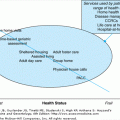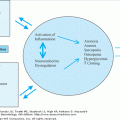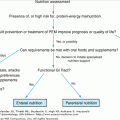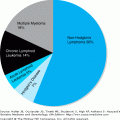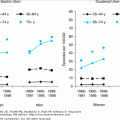Renal Disease: Introduction
The normal aging process induces structural and functional changes in the kidney characterized by progressive development of glomerulosclerosis and interstitial fibrosis. The timing of these changes is highly variable and is not necessarily inevitable, and appears to hinge on associated comorbid factors. Nearly one-third of the elderly population will not demonstrate a decrement in glomerular filtration rate (GFR) with aging. Nevertheless, the average individual can expect to lose 0.8 mL/min/1.73 m2/year. Because the decline in GFR in individuals with aging is masked by a proportional decline in muscle mass, the serum creatinine generally remains constant. Failure to understand this fact can result in inappropriate dosing of medications with their associated morbidity. It can also result in underrecognition of renal pathology, for even subtle increases in serum creatinine in the elderly can represent a significant loss of renal function. This chapter reviews aspects of renal disease that are prevalent in the geriatric population.
Epidemiology
There has been an increase in the prevalence of renal disease with increasing age as a consequence of improved patient survival with comorbid conditions that result in renal dysfunction, such as congestive heart failure, hypertension, diabetes, and atherosclerotic vascular disease. Currently, more than 20% of individuals older than age 65 years who are living in the United States have some degree of renal impairment, and 60% of the patients with end-stage renal disease (ESRD) who are on chronic dialysis are older than age 65 years. Men and women are affected equally. This is surprising given the higher incidence of renal disease in young men; however, these statistics may reflect the higher survival rate for women in general.
The true incidence of acute renal failure (ARF) in the elderly population is unknown. Multicenter studies from Europe report a threefold increase in the prevalence of ARF in older people. In a recent prospective multicenter European study of ARF involving hospitalized patients, more than 60% were older than age 60 years, with about one-third being older than age 70 years. The most frequent causes of ARF were acute tubular necrosis (ATN) (45%), prerenal azotemia (21%), acute on chronic renal failure (CRF) (13%), and obstructive uropathy (10%). Nearly half of the patients who later developed ARF had normal renal function on presentation to the hospital, and the mortality rate was 45%. The incidence of prerenal azotemia in the elderly population is probably much higher; data from a series of elderly patients in the United Kingdom and Spain show that of 571 patients with azotemia, approximately 40% had evidence of prerenal ARF.
The true incidence of glomerular disease cannot be determined in elderly patients because there are no population-based studies. Until recently, glomerulonephritis in geriatric patients received little attention because of fear of an increased risk of morbidity and mortality associated with renal biopsy, and to the more difficult interpretation of histopathological findings. The increased proportion of elderly people entering renal replacement therapy programs has prompted nephrologists to reconsider the actual prevalence of glomerulonephritis occurring in this population. Referral patterns suggest that proteinuria or renal dysfunction is the most common reason for renal biopsy. Of these cases, nearly one-third of the renal biopsies performed were for nephrotic syndrome, while another 50% were divided fairly equally between evaluation of acute and chronic renal insufficiency. Because of concerns for the safety and efficacy of the biopsy procedure in the past, older studies may not reflect the true incidence of disease. In fact, the Medical Research Council’s glomerulonephritis registry in the United Kingdom shows that the percentage of elderly patients in this registry has increased from 6% in 1978 to 21% in 1990, suggesting that the number of geriatric patients undergoing a renal biopsy for the diagnosis of glomerular disease has also increased. As a result, the incidence of glomerulonephritis in the elderly population may be much higher than previously recognized and is probably higher than in younger groups less than 60 years of age. Idiopathic glomerulonephritis is the most common diagnosis, accounting for 65% to 70% of all reported cases. Whatever the histology, a renal biopsy from an elderly individual is more likely to show more than one pathological lesion as well as more evidence of senescence; there is more likely to be more glomerular scarring, interstitial fibrosis, and tubular dropout. Among the glomerulonephritides (Table 86-1), membranous appears to be most common (37.7%) while minimal change (11.2%), amyloidosis (11.1%), focal segmental (7.4%), membranoproliferative (mesangiocapillary) (6.6%), other proliferative (13.3%), and nonproliferative (9.0%) account for the bulk of the rest. Because most patients with diabetic nephropathy can be presumptively diagnosed based on certain clinical criteria, its true incidence is underreported. For patients presenting with ARF, crescentic glomerulonephritis (31%), acute interstitial nephritis (18.6%), ATN with nephrotic syndrome (7.5%), atheroemboli (7.1%), light-chain cast nephropathy (5.9%), and postinfectious (5.5%) are the most commonly reported lesions. Longitudinal studies from Italy depict a changing pattern of glomerulonephritis in the elderly population with a much higher incidence of crescentic glomerulonephritis. Elderly patients with chronic renal insufficiency are most likely to have hypertensive nephrosclerosis, focal segmental glomerulosclerosis, interstitial nephritis, or amyloidosis on renal biopsy.
STUDY NO. | TOTAL (n) | NIL (%) | FSGS (%) | MEMB (%) | AMYLOID (%) | MCGN (%) | OTHER/PRO (%) | DIABETES (%) | OTHERS (%) |
|---|---|---|---|---|---|---|---|---|---|
1 | 63 | 21 | 16 | 33 | 14 | 5 | 5 | 5 | 1 |
2 | 164 | 21 | 3 | 38 | 12 | 5 | 14 | 4 | 3 |
3 | 107 | 2 | 15 | 48 | 10 | 5 | 4 | 5 | 11 |
4 | 317 | 11 | 4 | 37 | 11 | 6 | 13 | 4 | 13 |
5 | 50 | 4 | 4 | 32 | 22 | 4 | 34 | — | — |
6 | 31 | 6 | — | 52 | — | 16 | — | — | 22 |
7 | 35 | 6 | 3 | 43 | 3 | 3 | 23 | — | — |
8 | 92 | 14 | 0 | 35 | 20 | 11 | 15 | 1 | 2 |
9 | 33 | 27 | — | 39 | 9 | 6 | 6 | — | 13 |
10 | 87 | 8 | 0 | 34 | 10 | 8 | 15 | 0 | — |
11 | 59 | 3 | 6 | 21 | 7 | 4 | 5 | 8 | 5 |
12 | 76 | 25 | 4 | 41 | 13 | — | 13 | — | 8 |
Total | 1,114 | 11.2 | 7.4 | 37.7 | 11.1 | 6.6 | 13.3 | 3.7 | 9 |
There has been very limited information on the prevalence of renal disease in the very elderly (aged 80 years or older). Recently, a retrospective study reviewing renal biopsies from 2001 to 2003 compared the very elderly with other age groups. The most common indications for performing a renal biopsy in the very elderly group were ARF (23%), nephrotic syndrome (33%), and acute glomerulonephritis (20%). Other indications included: (1) rapidly progressing renal failure (6%), (2) chronic kidney failure (17%), and (3) asymptomatic urinary abnormalities (1%). Surprisingly, membranous nephropathy accounted for only a small percentage of idiopathic nephrotic syndrome (15%), while pauci-immune crescentic glomerulonephritis was the most common diagnosis (19%). At least 40% of the biopsies performed revealed pathological findings that would benefit from therapeutic intervention, suggesting that kidney biopsies can be beneficial in the very elderly.
Epidemiological surveys from England report that the prevalence and incidence of nephrotic syndrome in geriatric populations are similar if not higher than those in adult populations of all ages, with about 11 new cases per million people per year. Approximately 18% of newly diagnosed adults with nephrotic syndrome are aged 60 years or older. The incidence may be higher, but many geriatric patients are not referred for renal biopsy because of age and functional status. This is especially true for patients older than 80 years of age. Geriatric patients with type II diabetes mellitus are also generally underreported in renal biopsy registries because diabetic nephropathy may go unrecognized and because the diagnosis can often be made without the necessity of a renal biopsy. Yet, more than 40% of elderly patients with ESRD have underlying diabetic nephropathy as the etiology of their ESRD.
The frequency of renovascular disease in elderly patients is unknown. It may be an unexpected finding in patients investigated for nonrenal disease, but the prevalence of severe renal artery stenosis increases with age. Autopsy studies show that among those persons older than age 70 years at the time of death, 62% had severe renal artery disease. When present, renal artery stenosis was bilateral in 50% of cases.
A high incidence of renal artery stenosis among normotensive subjects also has been found in several patient cohort studies undergoing angiography. In one report of patients older than 50 years of age, 69% of patients with hypertension and 35% without hypertension had identifiable renal artery atherosclerotic disease. A prospective study from Duke University of 1302 patients undergoing elective diagnostic cardiac catheterization showed significant unilateral renal artery stenosis in 11% of patients and bilateral stenosis in 4%. Multivariate and univariate analyses identified several predictors of increased risk for significant renovascular disease, including older age, multivessel coronary artery disease, and congestive heart failure. Interestingly, a history of hypertension did not predict the presence of renal artery stenosis in this cohort. Other angiographic studies evaluating the prevalence of renal artery stenosis in patients with vascular disease have shown similar findings with a prevalence between 11% and 42%. The highest prevalence is found among patients with peripheral vascular and aorto-occlusive disease or aneurysms.
Renovascular disease may also occur in the setting of renal insufficiency. A recent report from Italy of a study that included elderly patients with renal insufficiency of unclear etiology and mild proteinuria (less than 1 g/d) showed a 56% prevalence of significant (>70%) stenosis at angiography. Other investigators have done angiographic screening of patients older than age 50 years entering renal replacement therapy programs and report finding renal artery stenosis in 11% to 16% of these patients.
Acute Renal Failure
ARF is defined as a sudden deterioration in renal function, sufficient to cause retention of nitrogenous waste in the body. The anatomic and physiological changes occurring in the aging kidney, the presence of comorbid medical conditions, the use of excessive numbers of medications, and the higher prevalence of obstructive uropathy are all contributing factors that can cause ARF in the elderly.
Prerenal azotemia, or functional ARF as a result of extracellular fluid contraction, is the main cause of ARF in the geriatric population (Table 86-2). The reduced renal blood flow and GFR associated with aging leads to a reversible state of ARF in the setting of superimposed volume contraction. Loss of fluids, internal fluid redistribution, decreased cardiac output, and medications are responsible for the majority of cases of prerenal ARF in older individuals. Common medications associated with ARF are nonsteroidal anti-inflammatory drugs (NSAIDs), angiotensin-converting enzyme inhibitors (ACEIs), and angiotensin II type 1 receptor antagonist blockers (ARBs). The development of ARF secondary to ACEIs or ARBs in patients with renal artery stenosis is well known; however, recent publications also report cases of ACEIs and ARB-related ARF in patients without renovascular disease. Furthermore, a study from France reported that 67.5% of ACEI-induced cases of ARF in elderly patients occurred in the absence of renal artery stenosis.
Prerenal (acute reversible renal hypoperfusion) ARF |
Hypovolemia |
Fluid loss |
Gastrointestinal |
Diarrhea |
Fistulas |
Vomiting |
Renal |
Diuretic intake |
Salt wasting |
Redistribution of the extracellular volume |
Shock (septic, cardiogenic), hypoalbuminemia, nephrotic syndrome, liver diseases |
Malnutrition |
Hemorrhage |
Inappropriate fluid restriction |
Interference with renal autoregulatory mechanisms |
ACEIs |
Cyclosporine |
NSAIDs |
Cardiac failure |
Acute |
Acute myocardial infarction |
Arrhythmias |
Cardiac tamponade |
Malignant hypertension |
Chronic: ischemic and hypertensive cardiomyopathies |
Valvulopathies |
Renal or intrinsic ARF |
Acute glomerulonephritis |
Mesangiocapillary |
Postinfectious |
Rapidly progressive |
Goodpasture’s syndrome |
Idiopathic |
SLE |
Vasculitis |
Hypersensitivity angiitis |
Classic |
Hemolytic-uremic syndrome |
Henoch-Schönlein |
Mixed cryoglobulinemia |
Scleroderma |
Serum sickness |
Wegener’s granulomatosis |
Polyarteritis nodosa |
Tubulointerstitial nephropathies |
Drugs |
ACEIs |
Allopurinol |
Ampicillin |
Analgesics (including NSAIDs) |
Cimetidine |
Diphenylhydantoin |
Methicillin |
Thiazides |
Infectious: acute pyelonephritis |
Infiltrative |
Leukemia |
Lymphoma |
Sarcoidosis |
Idiopathic |
Intratubular obstruction |
Myeloma proteins |
Myoglobin |
Sulfonamides |
Urates |
Hypercalcemia |
Hepatorenal syndrome |
Vascular obstruction |
Arterial |
Aneurysms |
Atheroembolic disease |
Venous: thrombosis of vena cava |
Tubule cell damage |
Nephrotoxin-related |
Antibiotics (aminoglycosides) |
Iodinated contrast media |
IV Immunoglobulin G |
Metals (Hg, Ag, Pt, Bi) |
Organic solvents |
Obstructive ARF |
Ureteral and pelvic |
Intrinsic obstruction |
Blood clots |
Fungus balls |
Sloughed papillae |
Diabetics |
Analgesic abusers |
Stones |
Extrinsic obstruction |
Fecal impaction |
Malignancy |
Retroperitoneal fibrosis |
Bladder |
Bladder carcinoma |
Blood clots |
Neuropathic |
Prostatic hypertrophy |
Stones |
Urethra |
Phymosis |
Strictures |
NSAID-induced ARF occurs more frequently in the elderly than in the general population, mainly because of the coexistence of conditions associated with decreased effective intravascular volume or true volume depletion. Under these conditions, the kidney is dependent on prostaglandins to maintain renal perfusion. Loss of this important autoregulatory mechanism results in ARF. Advanced age is an independent risk factor for developing ARF in patients taking NSAIDs, presumably because of the normal, aging-related decrease in GFR.
Parenchymal causes of ARF include ATN, acute interstitial nephritis, acute glomerulonephritis, and renovascular disease. The most common cause of biopsy-proven intrinsic renal failure in geriatric patients is rapidly progressive glomerulonephritis (RPGN). Vasculitis and idiopathic crescentic glomerulonephritis make up more than half of these cases.
ATN results from prolonged renal ischemia or from exposure to nephrotoxins. The causes of ATN are multifactorial; however, the most common cause in elderly patients is volume depletion associated with renal hypoperfusion and ischemia. Complications of major surgery including intraoperative hypotension, postoperative fluid loss, and arrhythmias account for approximately one-third of the cases of ATN in the elderly. Sepsis-induced ATN occurs just as commonly. Nephrotoxic drugs may also cause ATN. The former often results from a failure to consider age-related decreases in GFR while the latter is responsible for 10% of the cases or ARF. Aminoglycoside nephrotoxicity and radiocontrast-induced ARF are just two examples of drug-induced renal failure.
Cholesterol emboli are another important cause of ARF in the geriatric population. Cholesterol crystals can become dislodged from atherosclerotic plaques during intra-aortic procedures, or may even arise spontaneously, and cause ARF by obstructing small renal arteries. This entity is important to consider in any patient with ARF following cardiac catheterization or aortic angiography. Rhabdomyolysis, in the settings of acute immobilization, infectious disease, cerebrovascular accidents, crush injury, hyperosmolar conditions, hyponatremia, hypothermia, or falls is being recognized as a prevalent and underdiagnosed cause of ATN in the elderly.
Postrenal or obstructive renal failure is one of the most significant causes of ARF in the elderly and may occur in 5% of the cases presenting with ARF. Common causes of obstruction in the geriatric population include benign prostate hypertrophy; prostate carcinoma; retroperitoneal or pelvic neoplasms such as non-Hodgkin’s lymphoma, carcinoma of the bladder, cervix, ovaries, or rectum; and neurogenic bladder caused by diabetes mellitus. Prompt diagnosis is extremely important because prognosis for recovery of renal function depends on the length of time that the kidney is obstructed. As such, it is considered a true urological emergency. Therefore, it is imperative to exclude the possibility of obstruction in any elderly patient presenting with ARF, especially in those situations of previous urological pathology or recent abdominal surgery.
A complete history, with special attention to potential nephrotoxic drugs and clinical clues of obstruction, is fundamental in establishing the diagnosis of ARF. Physical findings may be very subtle in the elderly but postural hypotension is usually present in states of true volume depletion. The use of urinary sodium concentration or the fractional excretion of sodium as markers to differentiate between acute prerenal azotemia and established ATN are less reliable in the geriatric population than in the general population. Elderly individuals have a decreased ability to concentrate their urine or respond to sudden changes in sodium and water balance because of aging-related disturbances in the tubular handling of water and/or sodium reabsorption. Thus, in geriatric patients, the urinary indices may not be helpful in differentiating between prerenal and ATN as a result of the physiological changes associated with aging, and early nephrologic consultation is warranted in any patient with ARF. The most reliable indicator of prerenal azotemia is its reversal following volume repletion, and a judicious volume challenge is indicated if the patient is not volume overloaded.
In the setting of ARF, ultrasonography is the imaging procedure of choice for the diagnosis of obstruction, kidney stones, or renal masses, and for the determination of renal size. Although there are a few case reports of urinary tract obstruction secondary to prior malignancy with minimal or no dilation of the collecting system on ultrasonography, these cases are rare, and duplex Doppler ultrasonography may prove to be a useful diagnostic tool in these instances. Computerized tomography (CT) scans often do not provide any further diagnostic information and should be reserved for the cases in which the kidneys are poorly visualized.
Indications for renal biopsy in elderly patients with ARF include the following: (1) prolonged oliguria (3 to 4 weeks); (2) ARF associated with systemic illnesses such as vasculitis; (3) RPGN; (4) acute tubulointerstitial nephritis; and (5) anuria in the absence of obstruction. Advanced age alone is not a contraindication for renal biopsy.
The management of ARF in the elderly should follow the same principles as in the general population. Maintenance of adequate intravascular volume is paramount in maintaining renal blood flow. Hemodynamic monitoring in critically ill patients is preferable with right-heart catheterization as indicated to measure pulmonary capillary wedge pressure. The routine use of renal dose dopamine for ARF should be discouraged because of the lack of demonstrated efficacy in this setting. Fenoldopam, a dopamine-1 receptor agonist, has not been shown to have any benefit in the outcome of ATN. Moreover, combinations of α- and β-adrenergic agonists, or colloid and blood transfusions to increase cardiac output to supranormal levels are not helpful in the setting of established ATN. Medications should be adjusted for the degree of renal insufficiency and appropriate dietary sodium, potassium, and protein restrictions instituted. A Foley catheter should be placed to rule out and treat bladder outlet obstruction. A previously placed Foley catheter should always be replaced regardless of whether it flushes.
The indication for renal replacement therapy in ARF must be individualized for each patient and depends upon the volume status of the patient and the need for solute clearance. Timely renal consultation early in the course of ARF often obviates the need for dialysis intervention. For those patients with ARF requiring dialysis, the required dialysis dose has not been established and may hinge on volume status and catabolic state. Acute peritoneal dialysis (PD) and hemodialysis have been used in elderly patients with ARF with similar results and complications as in younger adult patients. Continuous renal replacement therapy (CRRT) offers the advantages of slow controlled ultrafiltration and efficient removal of small and middle molecules. The CRRT multicenter trials have shown mixed results in mortality compared with conventional dialysis but promising results with large volume hemofiltration CRRT. Biocompatible membranes are used routinely now because of improved outcomes in patients with ARF.
Nutritional considerations warrant special consideration for any elderly patient with renal disease. There are advantages in early appropriate restriction of sodium, potassium, phosphorus, and protein for the elderly patient with ARF. Restricting the dietary protein intake to 0.6 to 0.8 g/kg ideal body weight for those patients not yet on dialysis results in maintenance of nitrogen balance, control of metabolic acidosis, and control of elemental phosphorus normally excreted by the kidney. Potassium and sodium are restricted to 2 g per day based on nutritional requirements. For those patients on dialysis, the dietary protein restriction can be liberalized to 1 to 1.2 g/kg ideal body weight for hemodialysis patients and 1.2 to 1.4 g/kg ideal body weight for patients on PD.
The mortality rate for ARF remains high. For critically ill patients, mortality rates approach 60% with sepsis-induced ARF having a worse prognosis than nonseptic ARF. The influence of age on outcome of ARF is debated; however, the elderly patient generally has less renal reserve than a younger individual and is more prone to ARF. As a result, an elderly patient has a moderately worse prognosis than a corresponding younger patient. Nevertheless, age alone should not be used as a discriminating factor in therapeutic decisions concerning ARF.
Glomerular Diseases
There has been a change in the clinical approach toward patients with ARF or nephrotic syndrome in the geriatric population. Because of the routine use of ultrasonographic guidance for renal biopsies, as well as improvements in the size and accuracy of the biopsy needle, the success rate in obtaining a diagnostic renal biopsy that provides clinically useful information has improved to greater than 90%. This is important because ESRD caused by glomerulonephritis currently accounts for approximately 24% of patients requiring dialysis in Europe and a higher percentage in the United States. Recent reviews suggest that the clinical features, histopathologic classification, and clinical outcome of glomerulonephritis in elderly patients are comparable to those of younger adults. Based on these observations, a reliable diagnosis and an effective therapeutic plan have to be advocated in elderly patients similar to the approach taken in younger adult patients.
Elderly patients with biopsy-proven glomerulonephritis usually present with the following major clinical syndromes (Table 86-3): (1) nephrotic syndrome (50% to 60% in some series), characterized by heavy proteinuria and a variable tendency toward edema, hypertension, renal failure, and hyperlipidemia; (2) acute glomerulonephritis or acute nephritic syndrome, characterized by the abrupt clinical onset of hematuria, proteinuria, decreased GFR, fluid and salt retention, hypertension, and occasionally, oliguria; (3) RPGN, whose clinical pattern includes a more insidious onset, progressive loss of renal function, and, frequently, oliguria; (4) chronic glomerulonephritis, characterized by CRF accompanied by various degrees of proteinuria, hematuria, and hypertension, and a clinical course that is usually progressive but which may be protracted over several years; and (5) urinary abnormalities with few or no symptoms. Although an asymptomatic urinary abnormality is the single most common clinical presentation in younger patients, it is rarely found in geriatric populations (age ≥60 years). The reason for this difference may be the aging-related reduction in renal function, or the lack of routine urine testing in elderly patients even though they are more likely to be seeking advice for medical complaints.
AGE | ||||
|---|---|---|---|---|
>65 Yrs | 20–65 Yrs | |||
MODE OF PRESENTATION | (n) | (%) | (n) | (%) |
Acute renal failure | 37 | 14 | 240 | 11 |
Asymptomatic urinary abnormality | 17 | 6 | 841 | 38 |
Chronic renal failure | 54 | 20 | 168 | 7 |
Hypertension | 4 | 1 | 40 | 2 |
Nephrotic syndrome | 140 | 52 | 715 | 32 |
Unknown | 19 | 7 | 226 | 10 |
Total number | 271 | 100 | 2230 | 100 |
These two clinical syndromes often present as ARF in the elderly. The glomerular findings are similar to younger adults presenting with crescentic glomerulonephritis. Indeed, crescentic glomerulonephritis is the most common lesion found on renal biopsy in this group of geriatric patients. With aging, the glomerular basement membrane (GBM) becomes thickened and the glomerular surface area decreases. These changes tend to render the glomerulus more liable to immune complex-mediated damage. In addition, the increased prevalence of autoantibody and immune complexes in the elderly increase the risk of immunological-mediated glomerular injury, but these factors may be offset by the reduced renal plasma flow and the aging-associated impairment of cell-mediated immunity. This leads some investigators to believe that there may be other, currently unrecognized factors that increase the risk of developing glomerulonephritis in geriatric patients.
Postinfectious glomerulonephritis is present in approximately 6% to 8% of biopsy series of geriatric patients presenting with ARF. The clinical features are similar to those found in younger adults, but the clinical course is associated with a higher incidence of hypertension, azotemia, and ESRD. Underrecognized is postinfectious glomerulonephritis associated with aortofemoral bypass graft infections, especially those caused by Salmonella, which result in increased risk for morbidity and mortality.
Renal biopsies from patients with RPGN demonstrate extensive accumulation of cells in Bowman’s space (crescents). Although the disorders associated with RPGN can be classified as either primary glomerular disorders or secondary forms associated with infectious processes, multisystem disorders, or drug reactions (Table 86-4), three disorders deserve special attention in the elderly: antineutrophil cytoplasmic antibody (ANCA)-associated renal disease, hepatitis C-associated cryoglobulinemia, and Henoch–Schönlein purpura.
Primary diffuse crescentic glomerulonephritis |
Type I: anti-GBM-mediated disease without pulmonary hemorrhage (with anti-GBM) |
Type II: immune complex-associated disease (without anti-GMB or ANCA) |
Type III: pauci-immune (with ANCA) |
Type IV: mixed pattern (with anti-GBM and ANCA) |
Type V: pauci-immune (without ANCA or anti-GBM) |
Fibrillary and immunotactoid glomerulonephritis |
Focal sclerosis (rare) |
IgA nephropathy |
Mesangiocapillary glomerulonephritis (especially type II) |
Membranous glomerulonephritis (with or without anti-GBM) |
Superimposed on another primary glomerular disease |
Associated with infectious disease |
Hepatitis B and C |
Histoplasmosis |
Infective endocarditis |
Influenza (?) |
Mycoplasma infection |
Poststreptococcal glomerulonephritis |
Visceral abscesses |
Associated with multisystem disease |
Carcinoma (lung, bladder, prostate) |
Goodpasture disease (anti-GBM with pulmonary hemorrhage) |
Lymphoma |
Mixed (IgG/IgM) cryoimmunoglobulinemia (hepatitis C) |
Relapsing polychondritis |
Henoch–Schönlein purpura |
Systemic lupus erythematosus |
Systemic polyangiitis |
Churg–Strauss syndrome |
Microscopic polyangiitis (with ANCA) |
Wegener granulomatosis (with ANCA) |
Other variants |
Associated with medications |
Allopurinol |
Bucillamine |
d–Penicillamine |
